The challenges of onboard animal cameras
The challenge
Wild animals spend much of their lives hidden from our view, in locations we simply can’t get to. So, to reveal the secret side of their lives we needed the wildlife to do the filming for us.
We needed the animals to help us, help them.
The aim was to build high-resolution onboard cameras that could help scientific teams answer specific questions about wild animals.
The motivation was simple, as shark scientist Dr Tristan Guttridge put it “to save wildlife, first we need to understand it”.
The problem
Putting a mini camera on a wild animal is an exciting idea, but in reality, it’s extremely difficult. The cameras had to be small enough to go unnoticed by the wildlife, yet big enough to hold sufficient battery power. They had to deal with saltwater, rain, heat, dust, cold, shock and be comfortable for the furry film crew.
Fitting a camera on an animal is only half the issue. Getting it back again is another problem entirely.
Fitting a camera on an animal is only half the issue. Getting it back again is another problem entirely.
There is no off-the-shelf option, nobody sells a bat-camera - we looked. Each camera had to be made-to-measure, designed around the animals’ welfare. We collaborated with scientific teams who oversaw and signed-off each camera design. Strict limits were set on the size, weight and shape of the cameras as well as attachment methods and the duration of their deployment. In addition, we had to ensure the camera recorded at the right moment and work out how to get it back.
The solutions
Loggerhead turtle
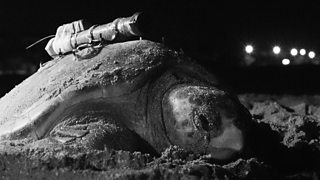
The aim was to prove that these turtles were feeding during their nesting season, so we needed a high-resolution underwater camera that could capture the action.
Unlike some turtle species, loggerheads have a particularly rough shell, which meant we couldn’t use suction cups to mount the camera. Instead, we had to use a non-toxic, temporary glue to anchor the camera safely. It’s a technique used regularly by turtle scientists to fasten GPS trackers. We integrated a series of galvanic timed-release bars into the design, which degraded at a set rate and allowed the camera to come loose after a specified time, so we could predict when the camera would drop off more accurately. We allowed around 24 hours for the turtle to get used to its new attachment before the camera started recording, which would last 19 hours, a really long time for an onboard camera. Then we could collect it by using an inbuilt satellite tag and a UHF radio tracker, although these aren’t as accurate as you might expect and when you add waves, strong currents and poor satellite coverage into the mix, it makes finding a small camera in the middle of the ocean a very difficult task.
Reef shark
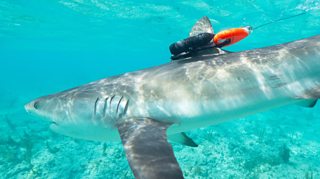
Designed by Marcus Shirley, the shark camera was perhaps the most advanced system we deployed. We wanted to see how healthy the sharks’ habitat was and how these predators used the coral reef. The difficulty is that these are fast moving predators that can dive surprisingly deep, so we had to ensure the entire device was pressure rated to 500m and it all needed to be hydrodynamic to help it slip through the water.
To provide the best view, the camera had to be mounted to the shark’s dorsal fin, which meant creating a bespoke fin clamp lined with shark-friendly pads that would gently hold it place. This clamp was tested on a very tame shark at The Deep aquarium in Hull, where we could see exactly how it fitted and make any minor adjustments to ensure the shark was comfortable.
Integrated into the clamp was a special metal bar which dissolved in saltwater at a specific rate. When this disintegrated, the clamp would spring open and the camera would float to the surface thanks to some foam. It was critical to get the amount of foam buoyancy just right; too much would affect the shark’s swimming behaviour but not enough would cause the camera to sink. Most buoyant foam will crush under the pressure of deep water, making it useless, so we needed a special syntactic foam that could go to 500m below.
If everything worked correctly, the device would float to the surface and an inbuilt satellite beacon released a signal and gave us an approximate location every few hours. We could then pin-point the camera using a handheld satellite receiver which worked every time, much to the relief of the team.
Gannet
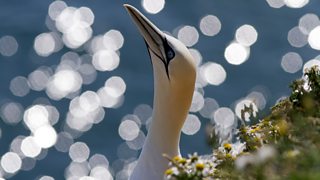
Gannets are famous for their high dives, but we wanted to know how they find fish in the open ocean. So, we needed a lightweight camera with a wide-angle lens that could film in flight and underwater.
Designer Chris Watts managed to make a gannet camera that weighed just 60g, 2% of the bird’s body weight. Gannets can carry around 400g of fish back to their nest after a single foraging trip, so we knew our camera was easily light enough for the job. But when a gannet plunge dives into the water, it can experience 9G as it decelerates, so our camera had to be extremely robust to deal with this impact. All of the components were arranged in a bullet shape to give a very small frontal area, minimising drag. To test the system, we strapped it to an arrow and fired it out to sea to ensure it could handle the shock. We got a few interesting looks from the local beach goers, but thankfully the camera passed the test with flying colours.
When we were ready for a proper deployment, the camera was carefully taped to the central tail feathers of the gannet, which is where previous scientific studies have attached similar sized GPS trackers. The tape being used was surprisingly fragile, so if the bird didn’t like the new accessory, it could easily rip it off.
On Animals With Cameras we labelled gannets as “boomerang animals”, meaning they come back to the same spot. The scientific team were therefore able to attach a camera to one specific gannet with full confidence it would return to the same site a couple of days later. This means the camera didn’t need any special drop-off device or complicated retrieval method, just a lot of patience from the team waiting for the right gannet to come back to the colony.
Northern elephant seal pups
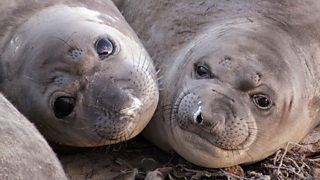
These seal pups were abandoned by the mother at 4 weeks old and we wanted to see how they prepare for adult life.
Thankfully, even a 1 month old pup is enormous, weighing over 120kg, as a result the size and weight restrictions for the mini camera were relatively lenient, at least compared to the other species we’d been dealing with. In fact, we were able to attach a battery big enough to collect over 13 hours of footage.
Because the pups spend a lot of time hauled out on the beach, it was very easy to attach and detach the camera by hand.
The scientific team involved were from University of California, Santa Cruz and they use a non-toxic, temporary glue to attach GPS tags, so the same method was used of the cameras. The pups travel back and forth from the shallow coastal waters to their favourite beach, so it was easy to find the same seal again and carefully remove the camera by hand.
Flying fox
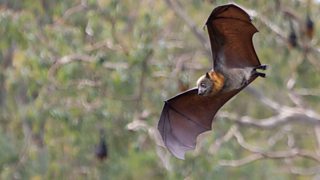
Creating a camera to fit on a bat was undoubtably the hardest challenge our camera designer Chris Watts faced in this series. We wanted to film the bats at night to see exactly what they were eating but this presented a lot of problems.
To capture the action in darkness, Chris installed two tiny infra-red lights that the camera could detect but the bat could not. The lights and camera were then attached to a small harness that could be carefully strapped around the bat giving us a great point of view. But to get the camera back, the harness needed to be released via a remote-control system and this took a long time to get right. After a lot of work, it could release on demand or via a pre-programmed timer, importantly there was also a backup so if the onboard battery got low it would use its last bit of power to automatically release the camera, keeping the bat safe.
It was crucial that the camera recorded at exactly the right time, so Chris designed a programmer that allowed us to set start and finish recording times. This programme system was actually installed in many of our animal cameras, allowing us to maximise our chances of capturing the right behaviour and the right moment.
The greatest achievement was getting all of this technology into a package weighing 35g, including the harness. To get it this light, Chris had to re-solder all of the electric boards, removing excess solder and snip fractions of a millimetre off the electrical wires to save weight. This is a truly remarkable achievement given that the latest action cameras on the high street weigh around 480g.
Koala
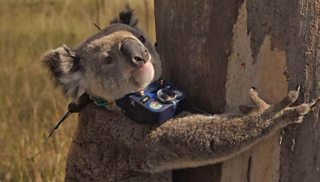
Despite their reputation as sleepy, layabouts, koalas can be remarkably active under the cover of darkness.
To see what they get up to, we created a programmable camera that would record at dawn and dusk and fitted it with infra-red lights, invisible to the koalas but not our cameras.
The camera was attached to the koala using a special neck collar, based on a GPS tracking device used by conservationists to monitor their movements. The camera was able to swivel forward and backwards so it would always be pointing in the right direction and not get in the way of their arboreal activities.
We also installed a remote-control release mechanism so that the camera would drop off without needing to catch the animal again.
Kangaroo
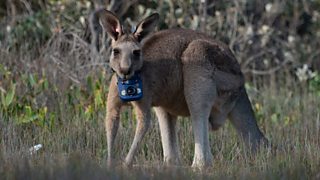
One population of kangaroos in eastern Australia had been seen using the local beach, but local scientists had no idea why, so they needed our camera to find the answer. Our kangaroo camera was very similar to the koala unit and equally well designed to cope with the Australian heat.
To deal with the bouncing locomotion of a kangaroo, the camera was mounted on a neck collar made of stretchy neoprene. This gave it a snug fit but also flexed and moved with the animal as it bounced along.
The remote-control release system was fitted with a special weak link built into the collar. This would snap easily if the animal got snagged in some undergrowth and the camera would then rip off and leave the animal free to hop off safely.
